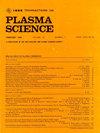Study of a High-Efficiency Depressed Collector for 0.22 THz Traveling Wave Tube Amplifiers
IF 1.3
4区 物理与天体物理
Q3 PHYSICS, FLUIDS & PLASMAS
引用次数: 0
Abstract
A three-stage depressed collector with significant features of high collection efficiency and low back-streaming rate is designed for a 220 GHz sheet beam traveling wave tube (SB-TWT). To make the simulation model close to the realistic situation, the spent electron beam was obtained from the end of the beam-wave interaction system based on the actual electron optics system (EOS) rather than the ideal one. However, if the extracted spent electron beam is directly used for the design of a collector, it will greatly increase the simulation time and even make the simulation collapse. To address this issue, multiple samplings of the spent electron beams are employed. Based on the position and energy distribution of the sampled spent electron beam, the collector is designed by using computer simulation technology (CST). Simulation results show that the collection efficiency and back-streaming rate for the case having considered secondary electrons are up to 95.7% and 0.07%, respectively. In addition, the thermal analysis has been conducted for the designed collector by using ANSYS software. Simulation results show that the maximum temperature and deformation of the collector are用于0.22 THz行波管放大器的高效抑制集电极研究
针对220 GHz板束行波管(SB-TWT),设计了一种具有高收集效率和低反流率的三级抑制集热器。为了使仿真模型更接近实际情况,利用实际的电子光学系统(EOS)而不是理想的电子光学系统,从波束相互作用系统的末端得到废电子束。但是,如果将提取的废电子束直接用于集热器的设计,将大大增加仿真时间,甚至使仿真崩溃。为了解决这个问题,对废电子束进行多次采样。根据采样后废电子束的位置和能量分布,利用计算机仿真技术设计了集热器。仿真结果表明,在考虑二次电子的情况下,收集效率可达95.7%,回流率可达0.07%。此外,利用ANSYS软件对所设计的集热器进行了热分析。仿真结果表明,当散热基板对流系数为25 W/m $^{2}~^{\circ}$ C时,集热器的最大温度为$221.5~^{\circ}$ C,最大变形量为$ 0.173 mm。
本文章由计算机程序翻译,如有差异,请以英文原文为准。
求助全文
约1分钟内获得全文
求助全文
来源期刊

IEEE Transactions on Plasma Science
物理-物理:流体与等离子体
CiteScore
3.00
自引率
20.00%
发文量
538
审稿时长
3.8 months
期刊介绍:
The scope covers all aspects of the theory and application of plasma science. It includes the following areas: magnetohydrodynamics; thermionics and plasma diodes; basic plasma phenomena; gaseous electronics; microwave/plasma interaction; electron, ion, and plasma sources; space plasmas; intense electron and ion beams; laser-plasma interactions; plasma diagnostics; plasma chemistry and processing; solid-state plasmas; plasma heating; plasma for controlled fusion research; high energy density plasmas; industrial/commercial applications of plasma physics; plasma waves and instabilities; and high power microwave and submillimeter wave generation.
 求助内容:
求助内容: 应助结果提醒方式:
应助结果提醒方式:


